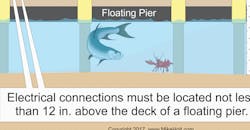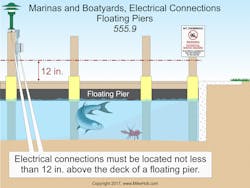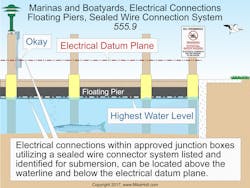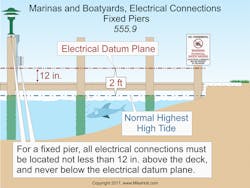Article 555 covers the installation of wiring and equipment for fixed or floating piers, wharfs, docks, and other areas in marinas, boatyards, boat basins, boathouses, and similar occupancies, including one-, two-, and multifamily dwellings, and residential condominiums. These installations are also covered by the applicable requirements in Chapters 1 through 4. For example, GFCI protection is required for outdoor 15A and 20A, 125V receptacles [210.8].
Electrical datum plane
Water levels aren’t constant. Ocean tides rise and fall, while lakes and rivers vary in depth in response to rain. To provide power to a marina, boatyard, or docking facility, you must allow for these variations in water level between the point of use and the electric power source. Article 555 addresses this issue.
Article 555 begins with the concept of the electrical datum plane [555.2]. You can think of it as a line that marks the beginning of a “no man’s land” where you simply don’t place electrical equipment. Once you determine where this plane is, don’t locate transformers, connections, or receptacles below that line.
Land areas that are:
- Subject to tidal fluctuation, it’s the horizontal plane 2 ft above the highest high tide that occurs under normal circumstances [555.2(1)].
- Not subject to tidal fluctuation, it’s the horizontal plane 2 ft above the highest water level that occurs under normal circumstances [555.2(2)].
For floating piers, it’s the horizontal plane 30 in. above the water level at the floating pier and a minimum of 12 in. above the level of the deck [555.2(3)].
Electrical equipment requirements
Transformers must be approved by the authority having jurisdiction (AHJ) for the location, and the bottom can’t be below the electrical datum plane [555.5]. Service equipment for floating docks or marinas can’t be located on the floating structure [555.7].
What’s a marine power outlet? It isn’t necessarily a receptacle. It’s an enclosed assembly that can include equipment such as receptacles, circuit breakers, fused switches, fuses, watt-hour meters, panelboards, and monitoring means approved for marine use [555.2].
Remember this definition when applying shore power receptacles [555.19(A)(1)] and disconnecting means [555.17(B)].
The overcurrent protection device(s) (OCPD) that supply marinas, boatyards, and commercial and noncommercial docking facilities must have ground-fault protection not exceeding 30mA [555.3].
The 2017 requirement is significantly different from its predecessor. The 2014 NEC had a 100mA threshold, and the requirement applied only to the main OCPD feeding the marina.
Electrical connections must be at least 12 in. above the deck of a floating pier (Fig. 1). If the conductor splices are contained within approved junction boxes using sealed wire connector systems listed and identified for submersion, they can be above the waterline but below the electrical datum plane for floating piers [555.9] (Fig. 2).
For a fixed pier, electrical connections must be at least 12 in. above the deck and never below the electrical datum plane (Fig. 3).
Electrical equipment enclosures must be securely and substantially supported by structural members, independent of any raceway connected to them. If installing them on piers, ensure they won’t interfere with mooring lines [555.10].
Load calculations
The ungrounded and neutral service or feeder load for shore power receptacles can be calculated using the adjustment factors of Table 555.12. Per Note 1 in that table, if shore power provides two receptacles having different voltages for an individual boat slip, only the receptacle with the larger kilowatt demand rating must be included in the calculation.
Wiring methods and installation
Any Chapter 3 wiring method is permitted if identified for use in wet locations [555.13(A)(1)]. You must use raceways to protect wiring above the decks of piers and landing stages.
You can use portable power cables if they have an outer jacket resistant to temperature extremes, oil, gasoline, ozone, abrasion, acids, and chemicals. But these cables must be [555.13(A)(2)]:
- Sunlight resistant.
- Extra-hard usage.
- Listed for wet locations
- Properly supported [555.13(A)(4)].
- Located on the underside of the pier.
- Securely fastened by nonmetallic clips to structural members other than the deck planking.
- Not be subject to physical damage.
- Protected against chafing by a permanently installed oversized sleeve of nonmetallic material when cables pass through structural members.
The equipment grounding conductor (EGC) must be an insulated conductor, and conductors 6 AWG and smaller must have a continuous outer finish that’s green or green with one or more yellow stripes [555.15(B)].
EGCs 4 AWG and larger or multiconductor cables can be identified per Sec. 250.119.
The insulated EGC must be sized per Sec. 250.122, based on the rating of the OCPD, but not smaller than 12 AWG [555.15(C)].
Boat receptacle disconnecting means
A disconnecting means must isolate each boat from its shore power receptacle [555.17]. A circuit breaker or switch (or both) must be used to serve as the required shore power receptacle disconnect, and it must be identified as to which receptacle it controls.
The disconnect for shore power receptacles must be readily accessible and not more than 30 in. from the receptacle it controls. Circuit breakers or switches in marine power outlets can be used for the shore power receptacle disconnect.
This shore power receptacle disconnect is intended to eliminate the hazard of engaging or disengaging the boat’s shore power attachment plug with wet, slippery hands and possibly contacting energized blades. The “30-in. requirement” helps someone not familiar with the marina layout to quickly reach the disconnect in an emergency.
Receptacles
Receptacles must be mounted at least 12 in. above the deck surface of the pier and not below the electrical datum plane on a fixed pier [555.19].
15A and 20A, 125V receptacles installed outdoors, in boathouses, buildings/structures used for storage, maintenance, or repair must be GFCI protected in accordance with Sec. 210.8 [554.19(B)]. These are “receptacles serving other than shore power.” For receptacles serving shore power, the following requirements apply [554.19(A)]:
- Receptacles intended to supply shore power to boats must be part of a listed marine power outlet enclosure, be installed in listed enclosures protected from the weather, or in listed weatherproof enclosures. The integrity of the assembly can’t be affected when the receptacles are in use with a booted or non-booted attachment plug/cap inserted.
- An individual branch circuit of the voltage class and rating corresponding to the rating of the receptacle must supply each receptacle that supplies shore power to boats. Informational Note: Supplying 120/240V, 3-wire receptacles from a 120/208V, 3-wire supply may cause overheating or malfunctioning of connected equipment.
- Single receptacles that provide shore power for boats must be rated at least 30A.
- Receptacles rated 30A and 50A must be of the locking and grounding type.
- Receptacles rated 60A or higher must be of the pin and sleeve type (prior to the 2017 NEC, the requirement was for “receptacles rated 60A and 100A”).
The rating of the shore power receptacle doesn’t depend on the length of the boat. The Code sets a minimum rating of 30A and leaves it up to the designer and/or owner to provide the receptacles they deem necessary based on the projected usage of the slips.
Repair facilities. Electrical wiring and equipment at marine craft repair facilities containing flammable or combustible liquids or gases must comply with Art. 511, in addition to the requirements of Art. 555 [555.22].
Important rules in Art. 511 to consider include:
- Sec. 511.3 [Classification of Hazardous Areas]
- Sec. 511.4 [Wiring and Equipment in Hazardous (Classified) Locations]
- Sec. 511.7 [Wiring and Equipment Above Hazardous (Classified) Locations]
- Sec. 511.9 [Explosionproof Seals]
- Sec. 511.12 [GFCI-Protected Receptacles]
Shock hazard signage
New with the 2017 NEC is the requirement for a permanent safety sign [555.24]. The sign gives notice of electrical shock hazard risks to persons using (or swimming near) a boat dock or marina. Such safety signs must:
- Warn of the hazards using effective words, colors, or symbols or combination per 110.21(B)(1) and be of sufficient durability to withstand the environment.
- Be clearly visible from all approaches to a marina or boatyard facility.
- State: WARNING — POTENTIAL SHOCK HAZARD — ELECTRICAL CURRENTS MAY BE PRESENT IN THE WATER.
Reducing fatalities
The 2017 revision didn’t bring many changes to Art. 555. The changes it did bring (e.g., stricter GFCI protection and warning sign) are squarely aimed at reducing fatalities from electrical shock. The 2017 revision also makes it clear that non-commercial facilities aren’t exempt.
The number of fatalities in these installations has been disgracefully high for a long time. Please, let’s all make fatality reduction a front-of-mind concept when performing work in these installations.
These materials are provided to us by Mike Holt Enterprises in Leesburg, Fla. To view Code training materials offered by this company, visit www.mikeholt.com/code.About the Author

Mike Holt
Mike Holt is the owner of Mike Holt Enterprises (www.MikeHolt.com), one of the largest electrical publishers in the United States. He earned a master's degree in the Business Administration Program (MBA) from the University of Miami. He earned his reputation as a National Electrical Code (NEC) expert by working his way up through the electrical trade. Formally a construction editor for two different trade publications, Mike started his career as an apprentice electrician and eventually became a master electrician, an electrical inspector, a contractor, and an educator. Mike has taught more than 1,000 classes on 30 different electrical-related subjects — ranging from alarm installations to exam preparation and voltage drop calculations. He continues to produce seminars, videos, books, and online training for the trade as well as contribute monthly Code content to EC&M magazine.




